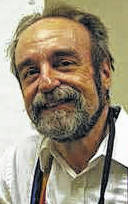
By Tom Burns
Stargazing
The next time you read some weird claim about astronomy, remember that anybody, con artists and careful thinkers alike, can get on the internet.
Moreover, even the most meticulous experiments can lead to dubious conclusions. The difference between science and mere speculation is that good scientists don’t completely trust their own observations without a ton or so of outside verification.
An example is the strange case of 4 Herculis, a star in the constellation Hercules. “4 Herc” is technically just above naked-eye visibility. However, if you’re observing in or near our light-polluted cities, you’ll need binoculars to see it. The star is part of a little triangle of stars just above the left-most side of Hercules’ “Keystone.”
That unassuming speck was, in its time, the center of a raging controversy about the chemical elements found inside stars.
Astronomers determine the composition of a star by breaking up its light into its rainbow band of colors, its spectrum. To create that spectrum, astronomers attach a complex series of lenses and prisms to the back of a telescope. The result is a series of discrete lines of color. As a star’s explosive force heats the elements in it, each element glows in specific, identifiable lines of the spectrum.
However, most of the light must shine through the star’s outer layer of gas. The chemical elements in that outer shell absorb some of the light, leaving a separate set of distinct dark lines.
Those “absorption” lines are the signatures of the elements that make up the outer shell. By looking for the dark lines, astronomers can tell what elements make up the star’s outer shell.
During the 1960s, French astronomers at the Haute-Provence Observatory began collecting the spectra of yellow dwarf stars, which are smaller and cooler than our sun. Two of them had bright lines that indicated the presence of potassium.
The strange part was that those lines were not dark, which would have indicated potassium’s presence. The lines were very bright, suggesting that the potassium was somehow igniting in a confoundingly unexpected way.
The astronomers searched for more “potassium flares” in other stars without much luck — until they came upon 4 Herculis, a hot, young, blue-white star with a run-of-the-mill spectrum except for extremely strong potassium lines. What in heaven’s name was going on?
A group of American astronomers at the Lick Observatory wanted to know.
The lead astronomer in the group has a local connection. Professor Emeritus Robert Wing had a long and distinguished tenure in the Ohio State University’s Department of Astronomy. Before that, he made his mark at the Lick Observatory.
The Lick Observatory group took spectra of 162 similar stars and discovered no potassium flares.
Professor Wing had an inspiration. He asked the group to take spectra of the light from garden-variety kitchen matches, which he knew contained potassium.
The same bright potassium lines that the French astronomers had found in 4 Herculis showed up in their test spectra. Similar tests at Haute Provence got the same results.
The Americans had solved the mystery. Astronomers get so tired by 2 a.m.
Who can blame them if they strike a match and light up a cigarette, a pipe, or a stogie to give them strength to start again on another star? Who would imagine that the brief flare of the potassium-embedded match could reflect off the internal structure of the telescope?
The result was bogus potassium flares. The French astronomers drew incorrect conclusions from incomplete evidence and freely admitted it.
As the internet increasingly demands our attention, we all can benefit from the example of those scientists.
Demand clear and convincing evidence the next time you read some elaborate conspiracy theory about extraterrestrial visitations or rigged elections. Question the logic of the claims.
If the evidence isn’t forthcoming, if the logic is twisted and ornate, please roll your eyes and move on.
Scientists repeat observations until a great weight of evidence confirms their conclusions. If you don’t believe the same attitude is helpful in our daily lives, I have a lovely star I’d like to sell you, a real bargain. It’s called 4 Herculis. You can see it with your unaided eye, no extra charge.
Tom Burns is the former director of the Perkins Observatory in Delaware.

